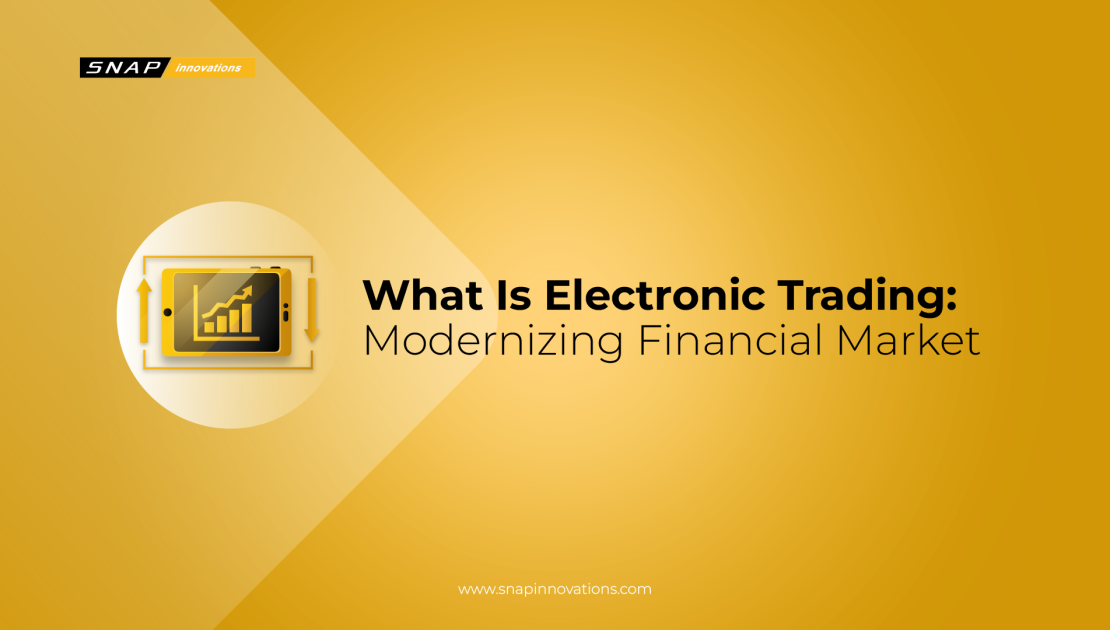What Is Electronic Trading? Revolutionizing Financial Markets

Electronic trading has emerged as a game changer in the ever-changing financial scene. It’s an idea that has transformed financial markets, transforming trading floors into digital hubs of innovation and efficiency.
We’ll delve into the realm of electronic trading in this piece, unraveling its complexities and learning how it’s transforming the very foundations of financial markets.
What Is Electronic Trading?
 At its core, electronic trading, often referred to as e-trading, is the digitalization of financial markets. It’s a departure from the traditional image of traders frantically waving hand signals on bustling exchange floors. Instead, it brings the world of trading to the screens of computers and mobile devices. The digital revolution in finance has fundamentally altered how financial instruments are bought and sold, making it more accessible, efficient, and interconnected.
At its core, electronic trading, often referred to as e-trading, is the digitalization of financial markets. It’s a departure from the traditional image of traders frantically waving hand signals on bustling exchange floors. Instead, it brings the world of trading to the screens of computers and mobile devices. The digital revolution in finance has fundamentally altered how financial instruments are bought and sold, making it more accessible, efficient, and interconnected.
Electronic trading encompasses a wide array of financial activities, including the buying and selling of stocks, bonds, currencies, commodities, and derivatives through electronic platforms. These platforms range from sophisticated trading terminals used by institutional investors to user-friendly mobile apps for retail traders. The key components of electronic trading include trading platforms, market data, order routing systems, execution venues, algorithms, a diverse group of market participants, and a regulatory framework designed to maintain market integrity.
Also Read: Business Unit Level Strategy in the Modern Business Landscape
One of the most remarkable aspects of electronic trading is its global reach, thanks to the power of the internet and high-speed data connections, allowing traders to access financial markets from virtually anywhere in the world, effectively democratizing trading. Furthermore, electronic trading operates 24/7, accommodating trading across different time zones and fostering market liquidity by efficiently matching buyers and sellers. Despite its reliance on complex technologies and algorithms, electronic trading has become incredibly user-friendly, with many trading platforms offering intuitive interfaces, educational resources, and customer support to assist traders of all levels. .
The Evolution of Electronic Trading
The journey of electronic trading is a fascinating one, marked by milestones that have shaped its present state. From the advent of electronic communication networks (ECNs) to the rise of algorithmic trading, this section will walk you through the major developments that have paved the way for the digital revolution in finance.
Let’s delve deeper into each of the 8 key milestones in the evolution of electronic trading:
1. Introduction of Electronic Communication Networks (ECNs)
ECNs were not only revolutionary for traders but also for market transparency. By providing real-time access to market data, ECNs allowed traders to see a more comprehensive view of the market, including the best bid and ask prices. This transparency made it easier for traders to identify optimal entry and exit points and led to tighter bid-ask spreads.
As ECNs gained popularity, they not only facilitated the transition from manual to electronic trading but also set the stage for the rise of high-frequency trading and algorithmic trading.
2. Emergence of Electronic Trading Platforms
Electronic trading platforms, which began to gain traction in the 1970s, not only automated order execution but also introduced features like limit orders and real-time quotes. These platforms brought efficiency to trading by enabling traders to specify price levels at which they wanted to buy or sell, reducing the need for constant monitoring of market conditions.
This feature became especially valuable for institutions and individual traders alike, allowing them to take a more strategic approach to trading.
3. Rise of Electronic Stock Exchanges
Electronic stock exchanges, exemplified by NASDAQ, disrupted the traditional stock exchange model. NASDAQ, founded in 1971, was one of the pioneers in electronic trading and quickly became known for its electronic marketplace.
Unlike traditional exchanges with physical trading floors, NASDAQ operated entirely electronically, allowing for faster order execution and the introduction of new order types like market orders and stop orders. This shift prompted other exchanges to embrace electronic trading to remain competitive.
4. Widespread Adoption of Electronic Trading
The 1990s witnessed a surge in electronic trading adoption, driven in part by advancements in technology and the internet’s growing reach. Online brokerage firms provided retail investors with easy access to electronic trading platforms, making it possible for anyone with an internet connection to participate in financial markets.
This democratization of access disrupted traditional brokerage models and contributed to the growth of retail trading.
5. Introduction of Algorithmic Trading
Algorithmic trading, which gained prominence in the early 21st century, brought a new level of sophistication to electronic trading. High-frequency trading firms used complex algorithms to execute orders in fractions of a second, capitalizing on minute price discrepancies.
Algorithmic trading not only increased trading speed but also enhanced market liquidity and introduced risk management tools like stop-loss orders, which could be executed automatically when predefined conditions were met.r
6. Democratization of Access
Electronic trading platforms and online brokerage accounts leveled the playing field, enabling retail investors to compete on a more equal footing with institutional traders.
This democratization led to a surge in retail trading activity and introduced concepts like social trading, where novice traders could follow and replicate the strategies of more experienced traders.
The ease of access and user-friendly interfaces of electronic trading platforms played a pivotal role in making financial markets more inclusive.
7. Integration of Blockchain and Distributed Ledger Technology
Blockchain and Distributed Ledger Technology (DLT) have the potential to revolutionize electronic trading by introducing trustless, decentralized systems for trade settlement and record-keeping.
Smart contracts built on blockchain platforms can automate various aspects of trade execution and settlement, reducing counterparty risk and the need for intermediaries. This innovation could lead to faster, more secure, and cost-effective trading processes, ultimately reshaping the financial industry’s infrastructure.
8. Role of Artificial Intelligence and Machine Learning
Artificial Intelligence (AI) and Machine Learning (ML) have become indispensable in electronic trading. AI-driven trading systems analyze vast datasets in real-time, identifying patterns and opportunities that human traders might miss. ML algorithms optimize trading strategies by learning from historical data and adapting to ever-changing market conditions.
As AI and ML technologies continue to advance, they are poised to play an even larger role in electronic trading, offering more sophisticated and adaptive trading solutions. These technologies are also contributing to the development of predictive analytics, allowing traders to make more informed decisions based on data-driven forecasts.
These detailed milestones illustrate the incredible journey of electronic trading, highlighting its transformative impact on financial markets. From its inception to the cutting-edge technologies driving it today, electronic trading continues to evolve, promising further efficiency, accessibility, and innovation in global financial systems.
How Electronic Trading Works
 Electronic trading operates through a sophisticated interplay of technology and financial infrastructure, orchestrated to facilitate seamless transactions across global markets. At its core, this process involves traders interfacing with electronic trading platforms or systems, which serve as the gateway to various financial instruments. Traders can access these platforms via computers, smartphones, or dedicated terminals.
Electronic trading operates through a sophisticated interplay of technology and financial infrastructure, orchestrated to facilitate seamless transactions across global markets. At its core, this process involves traders interfacing with electronic trading platforms or systems, which serve as the gateway to various financial instruments. Traders can access these platforms via computers, smartphones, or dedicated terminals.
When a trader initiates an order, whether it’s a buy or sell order for a particular financial instrument, the electronic trading platform processes the request. It employs algorithms and data analysis to match the order with a corresponding order from another market participant, often aiming to execute it at the best available price. Once the match is made, the platform executes the trade, and the ownership of the asset is transferred accordingly.
Throughout this process, electronic trading systems ensure transparency by providing real-time market data and trade execution information, empowering traders to make informed decisions. Additionally, risk management tools, order types, and automated features contribute to the efficiency and precision of electronic trading systems. Overall, electronic trading has revolutionized the financial landscape by offering speed, accessibility, and advanced functionality, making it a cornerstone of modern finance.
Benefits of Electronic Trading
Electronic trading isn’t just a buzzword; it comes with tangible advantages that have made it the preferred choice for traders and investors worldwide. From enhanced efficiency and accessibility to cost reduction and increased market liquidity, this section explores the myriad benefits that electronic trading brings to the table.
1. Enhanced Speed and Efficiency
Electronic trading is synonymous with speed. Transactions are executed in a matter of milliseconds, allowing traders to capitalize on fleeting market opportunities. This speed ensures that orders are filled at the best available prices, minimizing slippage and maximizing profit potential.
Furthermore, electronic systems eliminate the delays associated with manual order entry and execution, streamlining the entire trading process. This efficiency not only saves time but also reduces the risk of human error, contributing to improved trading outcomes.
2. Improved Transparency
Transparency is a cornerstone of electronic trading. Real-time access to market data, including price quotes, order book depth, and trade execution information, empowers traders with a comprehensive view of market conditions. This transparency reduces information asymmetry and fosters fairer and more competitive markets.
Traders can make more informed decisions based on the latest market data, leading to better trade outcomes. Additionally, electronic trading platforms often provide historical data, allowing traders to conduct in-depth analyses and refine their strategies over time.
3. Reduced Costs
Electronic trading significantly reduces transaction costs compared to traditional manual trading methods. The elimination of manual processes, such as phone calls or in-person trading, results in lower brokerage fees and spreads.
Moreover, electronic trading platforms often offer tiered fee structures, providing cost savings to high-volume traders. These cost efficiencies benefit both institutional investors and retail traders, enabling them to allocate more of their capital to trading strategies. Lower costs can lead to higher net returns and improved profitability.
4. Diversified Asset Access
Electronic trading opens doors to a vast array of asset classes and global markets. Traders can access equities, commodities, currencies, bonds, derivatives, and even cryptocurrencies from a single platform.
This diversification potential allows traders to spread risk across various assets and markets, reducing dependency on the performance of a single asset class. It also provides opportunities for portfolio diversification, which is essential for risk management and achieving long-term financial goals.
5. Advanced Order Types and Risk Management
Electronic trading platforms offer a plethora of order types and risk management tools. Traders can execute market orders for immediate execution, place limit orders at specific price levels, or employ stop-loss orders to limit potential losses.
Additionally, risk management features like margin requirements, position sizing, and automated alerts help traders maintain discipline and protect their capital. These tools enable traders to implement sophisticated trading strategies, manage risk effectively, and adapt to changing market conditions.
6. Global Accessibility
One of the remarkable aspects of electronic trading is its global accessibility. Traders can participate in markets worldwide, irrespective of their geographical location. This accessibility enables round-the-clock trading, allowing traders to respond to international market developments in real-time.
As a result, electronic trading has transformed financial markets into a truly global ecosystem. Traders can access opportunities in different time zones, diversify their portfolios across international markets, and respond swiftly to geopolitical events and economic news.
7. Algorithmic and Automated Trading
The rise of algorithmic trading has been a game-changer in electronic trading. Algorithms can analyze market data, execute trades, and manage portfolios with unmatched speed and precision. This automation minimizes human error and ensures adherence to predefined trading strategies. It also allows for strategies like arbitrage and market-making, which rely on split-second decision-making and execution.
Automated trading systems can run 24/7, constantly monitoring markets for trading opportunities, and swiftly executing orders when criteria are met. This level of automation not only enhances efficiency but also enables traders to capitalize on fleeting market inefficiencies.
8. Effortless Portfolio Management
Electronic trading platforms offer robust portfolio management features. Traders can effortlessly monitor the performance of their investments, view historical trade data, and assess risk exposure. Additionally, they can customize and diversify their portfolios, adjusting positions and strategies as market conditions evolve.
Portfolio analysis tools provide insights into asset allocation, risk profiles, and performance metrics. This level of visibility and control empowers traders to make informed decisions and fine-tune their portfolios to align with their financial objectives.
9. Data-Driven Decision-Making
Electronic trading is rooted in data analysis and quantitative models. Traders leverage historical and real-time data to make objective decisions, reducing the influence of emotions and biases. This data-driven approach promotes a systematic and disciplined trading strategy, leading to more consistent and reliable results.
Traders can conduct in-depth technical and fundamental analyses, develop trading algorithms based on historical patterns, and backtest strategies to assess their viability. The availability of comprehensive market data feeds and analytics tools enhances the precision and accuracy of trading decisions.
10. Scalability and Flexibility
Electronic trading systems are highly scalable, accommodating traders with varying trade volumes. Whether an individual trader is executing a few small orders or an institutional investor is managing a large portfolio, electronic platforms can adapt to the size and complexity of the trading task. This scalability allows traders to efficiently manage their strategies, whether they are trading on a small or institutional level.
Additionally, electronic trading platforms offer flexibility in terms of order customization, risk management, and strategy execution. Traders can tailor their trading parameters to align with their specific goals and risk tolerance.
In summary, the benefits of electronic trading extend beyond just speed and efficiency; they encompass transparency, cost savings, global accessibility, advanced tools, and data-driven decision-making. These advantages have transformed financial markets, making them more inclusive, efficient, and conducive to diverse trading strategies. As electronic trading continues to evolve, traders can expect further enhancements in technology and tools, offering even greater opportunities for success in the dynamic world of finance.
The Future of Electronic Trading
 The future of electronic trading holds promising developments that are poised to further reshape the financial landscape. One of the key directions is the continued integration of artificial intelligence (AI) and machine learning (ML) algorithms into trading systems. These advanced technologies can analyze vast datasets at lightning speed, identifying patterns, trends, and anomalies that human traders may overlook.
The future of electronic trading holds promising developments that are poised to further reshape the financial landscape. One of the key directions is the continued integration of artificial intelligence (AI) and machine learning (ML) algorithms into trading systems. These advanced technologies can analyze vast datasets at lightning speed, identifying patterns, trends, and anomalies that human traders may overlook.
This predictive power enhances decision-making and risk management, providing traders with a competitive edge. Furthermore, the rise of blockchain technology is expected to have a profound impact on electronic trading. Blockchain offers transparency, security, and efficiency in record-keeping and settlement, reducing the need for intermediaries and the risk of errors. As regulatory bodies adapt to the changing landscape, digital assets and cryptocurrencies may gain wider acceptance and be seamlessly integrated into electronic trading platforms.
Read More: Serverside Rendering: Unveiling its Power and Potential in Web Development
Additionally, the democratization of electronic trading is likely to continue, allowing individual investors greater access to diverse markets and asset classes, thanks to user-friendly mobile apps and trading interfaces. With these exciting prospects on the horizon, electronic trading is set to remain at the forefront of financial innovation, providing new opportunities and efficiencies in the digital future of finance.
Conclusion
In conclusion, electronic trading has emerged as a transformative force in the world of finance. It has democratized access to financial markets, enhanced efficiency, and ushered in a new era of trading.
Whether you’re a seasoned trader or a curious investor, understanding the dynamics of electronic trading is essential in today’s digital age. So, as you navigate the world of finance through your digital devices, remember that electronic trading is the driving force behind the evolution of financial markets.
